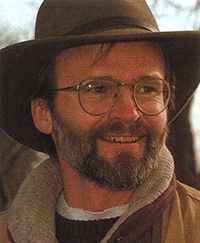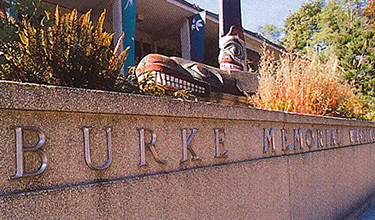Locked in the basement of the Burke Museum, he's the world's oldest political prisoner.
Alarms provide security. Officials record his every move. No one sees him alone.
Native Americans call him the Ancient One, but to the rest of the world he’s Kennewick Man, the object of a bitter tug-of-war to determine who owns the past.
Considered a landmark discovery, his 9,000-year-old skeleton arrived at the University of Washington in 1998 when the federal government picked the Burke Museum of Natural and Cultural History as his home until the courts determine his future.
Under normal circumstances, hosting a find like Kennewick Man would have been a coup for the Burke. But these weren’t normal circumstances. Not with a group of prominent scientists suing the federal government—and by extension five Pacific Northwest tribes—over control of the remains.
“We did not solicit this,” says Julie Stein, who was curator of archaeology at the Burke when the bones were transferred from the Pacific Northwest National Laboratory in Richland. “It was not a political arena that anyone would choose.” Nevertheless, given the Burke’s status as the state’s official natural history museum, “it was the right thing to do,” says Stein.
When it comes to Kennewick Man, doing the right thing has never been easy. More than four years have passed since hydroplane fans stumbled across his skull along the Columbia River, and still his ultimate fate—ongoing scientific examination or repatriation to the Confederated Tribes of the Umatilla—remains hostage.
The tribes did gain ground this fall when the federal government—responding to questions posed by a federal judge—reaffirmed an earlier decision that Kennewick Man ought to be repatriated. Even so, the Ancient One’s final destiny won’t be known until the lawsuit is settled.
“I think it’s a big victory for us [but] the scientists aren’t going to give up,” says Jeff Van Pelt, director of cultural resources programs for the Confederated Tribes.
Considering the injuries he sustained during his lifetime, this is not Kennewick Man’s first scuffle. However, it’s safe to assume no earlier fight involved the same volatile mix of race, religion, politics and science that supercharge the current conflict—a conflict that challenges the ethics of science, the validity of federal law and the very definition of Native American.

James Chatters
At ground zero of the controversy is UW graduate James Chatters, who earned his doctorate in anthropology in 1982. As the first anthropologist to study the remains, it was Chatters who dropped the pair of bombs that ignited the ongoing controversy.
Appearing at a press conference in Kennewick in August 1996—one month after the skull was discovered and numerous other bones retrieved—Chatters announced the skeleton was approximately 9,000 years old and displayed “Caucasoid,” not traditional Native American, features.
From that moment on, “everything went crazy,” recalls Chatters, who says he’s now regarded as either “a hero … or the anti-Christ” for his handling of the remains.
Chatters had managed the cultural resources program at the Pacific Northwest Laboratory in Richland before leaving to start his own business, Applied Paleoscience. He also occasionally volunteered to examine human remains for the Benton County Coroner. That is how Kennewick Man fell into his hands—as the subject of a forensic exam.
What happened during the month Kennewick Man was in Chatters’ custody set the dominoes in motion for everything that followed. While Chatters maintains all of his actions were “above board,” his critics accuse him of trampling the spirit—if not the letter—of federal law.
The primary law governing the case is the Native American Graves Protection and Repatriation Act (NAGPRA). Passed in 1990, it requires Indian remains and artifacts found on federal land to be returned to the appropriate contemporary tribe—provided the tribe has an affiliation—such as biological, cultural, historical, archaeological—with the bones or objects. Native Americans consider the remains of their ancestors—no matter how ancient—sacred. “The process of the passing of this life into the next is a very significant one,” says Van Pelt. “And that process is interrupted when the bones are uncovered.”
“If at first the tribe had been called in ... maybe there wouldn't have been this confrontation”
Eugene Hunn, UW ethnobiologist
On the face of it, the law would seem to be a thorn in the side of scientists, handcuffing their ability to thoroughly test and examine important discoveries. But Stein, a UW anthropologist and divisional dean of computing, facilities and research, is among those who take a different view.
“What NAGPRA has started among archaeologists is a culture of consultation that almost no project … is started without involving Native American people,” she says.
“It wasn’t perfect, but we were going in the right direction. Tribes were beginning to trust us and archaeologists were beginning to have relationships with these tribes that were close.
“The Kennewick controversy set that process back.”
Right from the get go, one provision of NAGPRA definitely applied to Kennewick Man. The remains were found on federal land. But were they Native American?
Chatters first guessed they belonged to a white settler. The condition of the bones ruled out a contemporary subject and the elongated skull did not match the rounder shape typically associated with American Indians.
However, after collecting and examining the rest of the skeleton, Chatters found something unexpected—a stone spearpoint, potentially thousands of years old, lodged in a pelvic bone.
Odds were he no longer was dealing with a white settler. And if Kennewick Man wasn’t a white settler, what else could he be but a Native American? And wouldn’t that mean his remains were protected by NAGPRA?
For Seattle Weekly staff writer and UW grad Roger Downey, ’65, the question was “what did Jim Chatters know and when did he know it?” Downey traced the twists and turns of the Kennewick Man case in a book published earlier this year called Riddle of the Bones—Politics, Science, Race and the Story of Kennewick Man. Riddle of the Bones grew from a piece Downey wrote for EastsideWeek after Peter Ward, a UW paleontologist and friend of Downey’s, sent the story to a publisher with the suggestion that it would make a good book.
Downey says he was “gratified” by the Interior Department’s finding that the remains belong to the Confederated Tribes of the Umatilla. “In this case, it was the best decision they could reach under law,” says Downey. “However, it doesn’t do anything about the squalid history of the case.”

Eugene Hunn
To many observers, the discovery of the spearpoint represented a crossroads that might have led to compromise instead of conflict. “If at first the tribe had been called in … maybe there wouldn’t have been this confrontation,” says Eugene Hunn, a UW ethnobiologist.
Van Pelt agrees. “We have a specific process … to do non-destructive studies in certain situations and this would have been one of them,” he says. Instead, Chatters submitted a finger bone for carbon dating—a destructive test discouraged by federal law. Four weeks later, Chatters learned he was in possession of one of the oldest and most complete human skeletons ever found in North America.
It was an exciting revelation—one made all the more intriguing by Kennewick Man’s lack of resemblance to modern Native Americans. His looks lend support to an emerging theory that humans did not arrive here in a single migration across a land bridge spanning the Bering Sea, but came in waves and from different regions.
To Chatters and many others, remains as ancient and physically dissimilar to contemporary Indians as Kennewick Man are outside the bounds of NAGPRA, which requires a preponderance of evidence showing an affiliation with an existing tribe in order to trigger repatriation.
The federal government disagreed. Soon after Chatters’ startling press conference, it claimed Kennewick Man in the name of NAGPRA and announced it was considering repatriating the bones to an appropriate tribe. The rationale was simple. How could anyone who lived here 9,000 years ago not be considered a Native American?
Quickly, eight scientists sued for the right to study the bones. When the judge hearing the case asked the feds for more facts to justify repatriation, it became clear that Kennewick Man’s legacy would be earned in court, not the lab. “This is a legal case, not a scientific case,” says Downey. “It was never stated, but the court case was brought by the plaintiffs in hopes they could eviscerate or eliminate NAGPRA entirely.”
Inspired by the need to redress the shameless robbing of Native American graves a century ago, NAGPRA does not provide much of a framework for deciding control of remains and artifacts thousands of years old. “The weakness in the law is the idea of antiquity and who gets to decide,” says Laura Phillips, archaeology collection manager at the Burke.
“In order to decide whether to study the remains, we have to study the remains.”
Eugene Hunn, UW ethnobiologist
Kennewick Man is the first test of the law, says Phillips. “This is certainly a precedent-setting case. Maybe they won’t change the law, but they will look to this case (in the future).”
Hunn sees a certain irony in the judge’s demand for additional facts. “In order to decide whether to study the remains,” he says, “we have to study the remains.” By now, says Hunn, much of what could be learned from Kennewick Man has been learned thanks to court-ordered tests and studies.
Van Pelt admits many things the tribe sought to prevent already have occurred, but he doesn’t think the tribe is in danger of winning only a Pyrrhic victory.
“Things happen for a reason,” he says. “Why did Kennewick Man choose this time to come back? He came back to bring all the Indian people together to fight for the natural world.”
Perhaps the most fundamental issue raised by this case is the question of who is a Native American. The answer, of course, varies from faction to faction, but few dispute the potency of the question. “What Kennewick Man will be known for is whatever happens with NAGPRA,” says Stein.
If Kennewick Man were a few hundred years old, not 9,000, and if his skeleton matched contemporary Native Americans, he would have been returned to the earth in a matter of days or weeks. But his age and appearance provided legal fodder for disputing his protection under NAGPRA.
“Ultimately, it comes down to a political battle,” says Hunn. While Hunn acknowledges Kennewick Man’s unique characteristics, he has no doubt about his status. “My sense is that if there was a man here 9,000 years ago, he was a Native American.”
Hunn is one of two UW professors—the other being Stein—who’ve participated in the court-ordered studies to determine whether repatriation is justified under the law.
Stein’s work, which involved studying sediments caking the bones to confirm Kennewick Man’s age, occurred two years ago. Hunn was part of a four-member team whose work last fall led the federal government to reaffirm its position on repatriation.
Hunn was invited to join the team after writing a critical letter. “It seemed to me there were some misleading perceptions in the public discussion of the issue,” he recalls. Primarily, he objected to the twisting of the phrase “Caucasoid features” to suggest a possible European heritage for Kennewick Man. “The idea that you could define Native Americans in physical terms rather than cultural terms seemed to me to be very misguided,” he says.
Downey suggests anti-repatriation forces fanned the Caucasoid flames to bolster their argument that Kennewick Man should not be considered Native American. “They were [feeding] the penchant of the press and public for booga-booga stories,” he says. At one point, a Norse pagan group, the Asatru Folk Assembly, made claims on the remains before dropping out.
By the time Hunn got involved, the government already had declared that anyone living in North America before Columbus was by definition a Native American. If accepted by the court, that would satisfy one repatriation requirement. However, the government still needed to demonstrate Kennewick Man’s ties with a contemporary tribe.
For the Confederated Tribes of the Umatilla, that’s a no-brainer. Their oral history teaches that they have always inhabited the region where Kennewick Man was found. Therefore, the Ancient One obviously is affiliated.
The government, however, sought harder evidence. By taking DNA samples from the bones, it hoped to establish a biological affiliation. And through research by Hunn and his teammates, the feds sought a cultural connection.
To Hunn’s way of thinking, establishing cultural links is a more relevant way of determining affiliation between past and present peoples than biological links. And when technical difficulties derailed DNA testing, it was cultural links that formed the basis for the government’s position.
Hunn’s task was to comb the records for evidence that the native tongue spoken by the region’s tribes today—Sahaptin—is kin to languages spoken there 9,000 years ago. “My conclusion was that as far as we could tell, Kennewick Man may very well have spoken a language related to the Yakama and the Umatilla,” he says. “If that’s true, you can say they are culturally affiliated by sharing a linguistic tradition.”
Chatters—who is not a plaintiff in the lawsuit—shakes his head at the notion of establishing a 9,000-year-old cultural affiliation, especially since Kennewick Man was found without any artifacts except the spearpoint in his pelvis. “It’s impossible,” he says. “It can’t be done.”
In some ways, says Hunn, maybe it is impossible. But then again, maybe that’s not the point.
As a scientist, Hunn would love to see the bones remain available for further study, not buried. Kennewick Man is a rare find with the potential to yield even more information in the future as technology produces new and better investigative techniques.
What’s more, as a white man, it wouldn’t bother Hunn a bit if someone measured, scraped and pawed the skeleton of his ancient ancestor. “But I’m not an Indian and they do care,” he says. “[They believe] the bones of their ancestors are sacred and should be treated as such and not the object of some scientific investigation.”
In the end, Kennewick Man is a classic test of the moral boundaries of science, says Hunn. “There seems to be an assumption that science should have carte blanche. I think you can easily come up with examples where that logic is seriously flawed.”
Guarding the man

The Ancient One’s remains are housed at the Burke Museum. Photo by Jon Marmor.
The Burke Museum of Natural and Cultural History has a skeleton in the closet. Well, not literally a closet, but the room where Kennewick Man rests his bones isn’t much bigger.
Of course, you’ll have to take Laura Phillips’ word for it. Phillips, archaeology collection manager at the Burke, won’t allow visitors to even see the door, much less peek inside.
The secrecy and security surrounding Kennewick Man’s stay at the Burke is not without reason. Several of his precious bones turned up missing at his previous home, the Pacific Northwest National Laboratory in Richland, where he spent the first two years following his discovery.
The bones currently are the property of the federal government pending resolution of a lawsuit that will decide whether they should be repatriated to the Confederated Tribes of the Umatilla or released to scientists for further study.
Kennewick Man arrived at the Burke in October 1998 after the federal judge hearing the case ordered the government to find a more suitable repository for the remains. That has put the Burke in a delicate middle ground between two of its primary constituents—Native Americans and researchers.
“We’re providing this service because we have the curatorial expertise,” says Phillips. “We don’t want to be perceived as taking one side or the other.”
During his stay at the Burke, Kennewick Man has undergone several court ordered tests and studies. Besides periodic government inspections, those are the only times his bones are brought out.
The bones—more than 300 of them—are stored in cardboard boxes stacked in a metal cabinet. Each box contains all the bones for a particular part of the body—feet, hands, arms, legs—and each bone nestles snugly into a custom-shaped cushion at the bottom of its box.
When tests and studies are performed, campus police are alerted and the entire archaeology lab shuts down. Researchers wait in an examination room while a representative from the Burke and the government retrieve the bones. The two observers remain in the room to take notes of the proceedings, then count all the bones before returning them to storage. Representatives from the tribe and from the plaintiff scientists also attend.
Julie Stein, former curator of archaeology at the Burke, participated in one of the early court-ordered studies. The anthropologist examined sediments clinging to the bones to authenticate their age.
Although she considered it an honor, the circumstances were draining. “It was nerve-wracking to have people watching everything you do and questioning everything you do and knowing their observations could very well end up as testimony in a court case,” she said.
Phillips says she fretted about potential confrontations between opposing parties in the case, but says everyone has remained calm. “Nobody wants it to get back to the court that they were behaving poorly,” she says. While the tribe is eager for the Ancient One to return to the earth from which he was taken, he has been in good hands at the Burke, says Jeff Van Pelt, director of cultural resources programs for the Confederated Tribes.
That doesn’t mean there haven’t been any complaints. Van Pelt says that after some bone samples were taken for DNA testing, pipes in the museum’s basement burst.
“That wasn’t the Burke’s fault,” says Van Pelt. “That was the power of the Ancient One.”